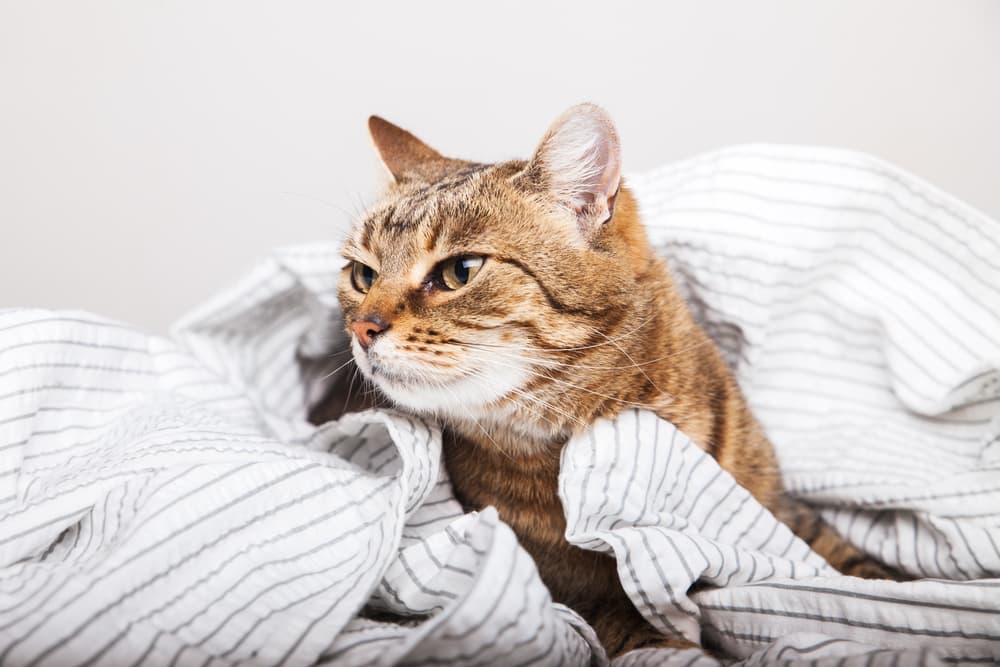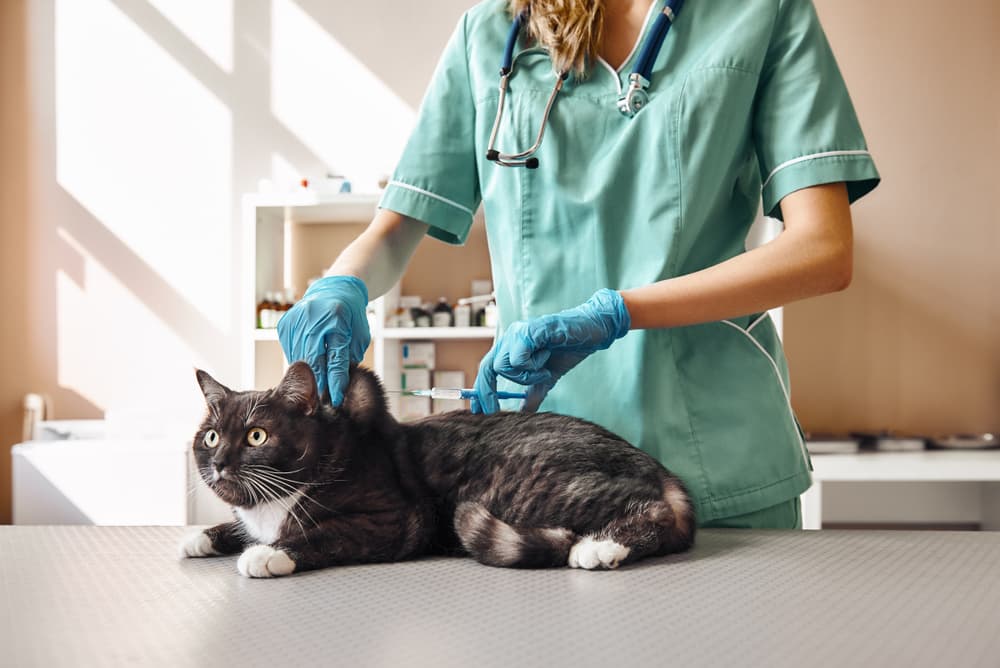Calicivirus in Cats

Overview
- Calicivirus is a viral respiratory infection in cats.
- It is contagious between cats, but doesn't spread to humans or dogs.
- Calicivirus is spread through aerosol droplets, eye and nasal discharge, and saliva.
- Treatment may include antibiotics, appetite stimulants, nose drops, and other medications.
- There is a vaccine to prevent calicivirus in cats. It is a core vaccine.
Cats are no strangers to respiratory infections. They’ll sneeze, sniffle, cough, and generally not feel too good.
Viruses commonly cause feline respiratory infections. Calicivirus rises to the top of the list of viral causes of respiratory disease in cats.
There’s a lot to learn about calicivirus in cats. Without further ado, let’s dive right in!
What is Calicivirus?
Calicivirus is part of the Caliciviridae family of viruses. Viruses in this family infect cats and other animals like reptiles, amphibians, and livestock.
Calicivirus affects wild and domestic cats all over the world. It primarily causes upper respiratory infections (nose, mouth, throat) and oral disease. Sometimes, though, it can spread down into the lungs, causing a lower respiratory infection.
There are many strains of calicivirus. They mutate rapidly and vary in severity. This is why, despite widespread use of a calicivirus vaccine (more on this later), calicivirus infections are still quite common in cats.
One particular strain of calicivirus, known as feline calicivirus-associated virulent systemic disease (FCV-VSD), makes cats very ill and can be fatal. Fortunately, this viral strain is rare.
A few other strains of the virus don’t cause respiratory infection at all. Instead, they affect the joints, causing FCV-associated lameness in our feline friends.
Is Calicivirus in Cats Contagious?
Yes, calicivirus is contagious. It can be spread from one cat to another via saliva, nasal droplets, or sneezing.
If you’re wondering whether a dog or human can get calicivirus from cats, though, rest assured that this virus affects only cats. It cannot be transmitted to, or spread among, other species.
How Do Cats Get Calicivirus?

Calicivirus spreads easily between cats. The tiny virus particles are contained within aerosol droplets, eye and nose discharge, and saliva.
A cat becomes infected when they come into direct or indirect contact with an infected cat’s eye and nose discharge, saliva, or aerosol droplets. For example, when an infected cat sneezes, virus-containing aerosol droplets land on and contaminate surfaces in the cat’s environment, such as toys or a food bowl. A cat that plays with a contaminated toy can become infected.
Newborn kittens can become infected if their mother is infected and passes on the virus to her babies.
Various cat populations, listed below, are at high-risk of calicivirus infections:
- Old cats
- Cats with chronic disease
- Young cats, especially kittens
- Cats living in high-density environments (e.g., shelters, catteries)
Symptoms of Calicivirus in Cats
Cats with a calicivirus infection don’t immediately show signs of illness. When the virus enters the body, there is a 2- to 14-day incubation period before symptoms become apparent.
During this incubation period, the calicivirus sets up shop in the lining at the back of the mouth. While there, the virus replicates and then spreads to other places. With FCV-VSD, the virus spreads to major organs, like the liver. With FCV-associated lameness, the virus reaches a cat’s joints.
Once the symptoms appear, they usually last about 2 to 3 weeks but may last as long as 6 weeks in severe cases. An infected cat continues to shed the virus while showing symptoms.
Upper respiratory symptoms, listed below, are typically the first signs of a calicivirus infection:
- Sneezing
- Squinting
- Eye discharge
- Nasal discharge
- Nasal congestion
- Conjunctivitis (inflammation of the lining of the eyelids)
Eye and nose discharge range from clear to yellow-green. Yellow-green discharge indicates a secondary bacterial infection that developed after the viral infection.
When the virus spreads to the mouth, infected cats develop painful oral ulcers on the tongue, gums, and lips. These ulcers cause excessive drooling.
Many cases of calicivirus are mild. However, if the infection becomes more severe, infected cats will show systemic signs of illness, such as weight loss, appetite loss, lethargy, and depression.
Cats with FCV-associated lameness will limp and have painful joints. Cats with FCV-VSD are critically ill, with symptoms like head and leg swelling, fever, and jaundice (yellow eyes, skin, and mouth).
Diagnosing Calicivirus in Cats

Veterinarians usually diagnose calicivirus according to symptoms. If your cat has symptoms of a respiratory infection, your veterinarian will take a history of your cat’s illness and perform a physical exam.
A definitive diagnosis of calicivirus is often not needed to begin treatment. However, there are some situations when a definitive diagnosis would be helpful. One such situation is multiple cats within one household becoming infected. Another is cats that are used for breeding.
To obtain a definitive diagnosis, a veterinarian would take a swab from the eyes, nose, or mouth and submit this sample to a diagnostic lab for virus identification. The virus can be identified in two ways:
- Polymerase chain reaction (PCR) test: a molecular test that detects viral DNA.
- Growing the virus in a petri dish.
Although these testing methods are accurate, false positives are possible. For example, a cat that was previously exposed to the virus in their environment will test positive, but may not be ill from the virus.
For cats with suspected FCV-associated lameness, X-rays would help rule out other causes of lameness, such as trauma.
If a cat has chronic respiratory symptoms that aren’t responding to treatment, chest X-rays, bloodwork, and eye and nose discharge analysis can help diagnose the problem. X-rays may also be done of the lungs to check for pneumonia or other secondary problems caused by the virus.
How to Treat Calicivirus in Cats
Treating calicivirus in cats is aimed at treating the symptoms rather than targeting the virus itself.
Fortunately, many cats infected with calicivirus fully recover from the infection. There’s a caveat, though. Recovered cats may continue to harbor the virus in their systems, making them carriers of the virus.
After recovery, about 50 percent of cats become carriers, either temporarily or for the rest of their lives. Carrier cats can shed the virus intermittently, making them sources of infection for other cats.
Several medications are available to treat calicivirus symptoms:
- Antibiotics to treat secondary bacterial infections.
- Appetite stimulants to increase appetite.
- Saline nose drops to relieve nasal congestion.
- Anti-inflammatory medications to reduce oral discomfort.
Supportive care measures are also recommended for cats infected with calicivirus. These include:
- Wiping away nose and eye discharge.
- Feeding extra tasty food to stimulate appetite.
- Environmental humidification (steam from a hot shower) to relieve nasal and airway congestion.
Cats with FCV-VSD need hospitalization and intense treatment, such as intravenous fluid, to make a full recovery. Unfortunately, nearly 70 percent of cats with FCV-VSD will not survive, despite treatment.
Cats with FCV-associated lameness will benefit from anti-inflammatories to relieve joint discomfort.
If you have multiple cats and one of them is being treated for calicivirus, isolate the infected cat during treatment. Disinfect the infected cat’s items (toys, bedding, litter box, food, and water bowls) with a mixture of 1/2 cup of bleach per gallon of water. Do not use Lysol because it is toxic to cats.
Although treatment costs vary between practices and geographic locations, the average cost of treating calicivirus virus in cats is about $300-$400. If an infected needs hospitalization and intensive treatment, that cost can rise significantly.
How to Prevent Calicivirus in Cats

With so many strains of calicivirus in cats, 100 percent protection from infection isn’t feasible. Fortunately, the prevention strategies listed below can significantly reduce your cat’s chances of developing a calicivirus infection:
Avoid interactions with unknown cats. Prevent direct contact between your cat and other cats, especially if you don’t know the other cat’s vaccination status.
Practice good sanitation measures. Wash your hands between handling multiple cats.
Be careful when introducing new cats. If you adopt a new cat, isolate them for 1 to 2 weeks and monitor them for respiratory symptoms.
Calicivirus Vaccine in Cats
Getting your cat vaccinated for calicivirus is an essential prevention strategy. The calicivirus vaccine is a core vaccine for cats.
Be aware, though, that the vaccine does not provide 100 percent protection against the virus. Even though a vaccinated cat can get calicivirus, the vaccine will help to reduce illness severity.
The vaccine comes in two formulations: nasal and injectable. The nasal formulation will cause a cat to sneeze for up to a week after vaccination.
The calicivirus vaccine is given in combination with other vaccines, including feline herpesvirus-1 and feline parvovirus.
The 2020 American Animal Hospital Association/American Association of Feline Practitioner Vaccination Guidelines recommend the protocol listed below for the calicivirus vaccine:
- Administer the first dose no earlier than 6 weeks of age.
- Administer subsequent doses every 3 to 4 weeks until the cat is 16 to 20 weeks of age.
- Administer vaccine boosters every 1 to 3 years.
There are some variations in the frequency of booster vaccinations. For example, if you’ll be boarding your cat, your veterinarian may recommend a booster vaccine before your cat enters the boarding facility.
Your veterinarian will determine how frequently your cat should receive a booster.
If your cat is older than 16 weeks of age at the time of the first vaccine, your veterinarian will follow a different vaccination protocol, such as giving two doses 3 to 4 weeks apart.









